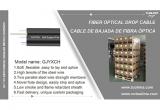.jpg)
What Is Transparent Optical Cable?
Transparent optical cable, also known as invisible fiber optic cable or clear jacket optical cable, is a new generation of fiber cable technology that combines data transmission performance with visual design.
Unlike traditional fiber optic cables, which are usually covered with opaque PVC or LSZH jackets, transparent optical cables use clear, light-transmissive materials that allow you to see the inner optical fiber cores and structural components. These cables are designed not only for function but also for aesthetic visibility — showing the beauty of light and technology in modern spaces.
At its core, a transparent fiber cable still performs the same essential function: transmitting light signals with minimal attenuation, ensuring high-speed connectivity for FTTH networks, smart homes, data centers, and IoT infrastructure. But what makes it unique is how it turns invisible technology into visible art.
When Did Transparent Optical Cables Become Popular?
The rise of transparent optical cables can be traced to the late 2010s, as fiber-to-the-home (FTTH) and 5G infrastructure expanded rapidly. Consumers began demanding more than just fast networks—they wanted seamless integration between connectivity and design.
With the growing adoption of smart home systems, interior designers and architects started searching for ways to hide or beautify wiring. Traditional optical cables, despite their high performance, were often visually intrusive in open or glass-heavy environments.
Then came transparent cable technology — first adopted by premium electronics brands and high-end display environments, such as showrooms, museums, and flagship stores. Apple’s retail stores, for example, showcased a minimalist aesthetic where every visible element conveyed precision and elegance. Transparent fiber cable fit this philosophy perfectly.
By the early 2020s, transparent optical cables began attracting attention in consumer installations, boutique hotels, exhibition halls, and even art installations. As users became more aware of design-driven connectivity, transparent fiber evolved from a niche product into a symbol of modern network design.
The Engineering Behind Transparency
At the technical level, transparent optical cables use a clear polymer jacket, typically made from high-purity thermoplastic elastomer or fluoropolymer, with excellent optical clarity and low refractive index. This enables light within the glass fiber to remain confined, even though the jacket is visibly clear.
Key components include:
Ø Optical fiber core — usually G.657A2 or G.652D bend-insensitive fiber for superior flexibility.
Ø Clear coating layer — protects against microbending loss and provides UV resistance.
Ø Transparent jacket — ensures aesthetic appeal while maintaining physical protection.
Ø Strength members — often Kevlar or fiberglass, embedded subtly to maintain the visual clarity.
These materials undergo UV-aging tests, temperature cycling, and bending stress analysis to ensure performance in real-world installations.
Compared to traditional outdoor fiber optic cables like ADSS cables or armored cables, transparent cables are optimized for indoor or semi-visible environments where appearance and flexibility matter more than mechanical strength.
Advantages of Transparent Optical Cable
Ø Aesthetic Integration — Perfect for interior designs that value clean lines, glass surfaces, and light-based design elements.
Ø Space Optimization — Eliminates the need for heavy ducting or opaque casing in visible areas.
Ø Bend Flexibility — Using bend-insensitive fiber allows tighter installation radius, ideal for compact indoor networks.
Ø Visual Quality Control — Because the inner structure is visible, installers and customers can easily inspect cable integrity.
Ø Smart Environment Compatibility — Works seamlessly with smart lighting, transparent routers, and IoT hubs.
Challenges and Responsible Usage
Despite their beauty, transparent optical cables are not designed for all environments. Their clear jackets, though visually appealing, offer less UV resistance and lower mechanical strength than armored or outdoor-rated cables.
That means transparent fiber is ideal for:
-- Indoor networks (FTTR, smart homes)
-- Exhibition displays and museums
-- Showrooms or public installations
But not for:
-- Long-distance aerial or underground routes
-- Environments with direct sunlight or harsh weather
-- Industrial or mechanical stress zones
Users should confirm operating temperature range, bending radius, and tensile load limits with their fiber optic supplier before large-scale deployment.
Transparent Fiber in Today’ s Market
In 2024–2025, transparent optical cables are seeing increased search volume in keywords such as transparent fiber optic cable, invisible FTTH cable, clear optical cable for smart home, and aesthetic fiber network.
Manufacturers are also exploring hybrid transparent cables — integrating LED threads, color-tuned light guides, or photochromic coatings to provide visual feedback during data transmission.
These innovations bridge functional connectivity with artistic expression — a convergence that appeals strongly to tech-savvy younger users and design-oriented commercial buyers alike.
The Future: From Utility to Experience
The next evolution of optical communication isn’ t just about faster data or longer spans — it’ s about how we experience connectivity. Transparent optical cables symbolize this transition from hidden utility to visible experience.
Imagine future office spaces or homes where the network glows gently, adjusting its tone to data flow or activity — a “ living” infrastructure. Transparent fiber will be the visual backbone of such environments.
As fiber optic technology continues to evolve, transparency will likely become a premium aesthetic category, much like how glass replaced steel in architecture to represent modernity.
Final Thoughts
Transparent optical cables redefine what we expect from fiber technology — merging engineering precision, visual design, and psychological connection. They are the embodiment of both performance and beauty.
At TUOLIMA, we believe visibility represents confidence. Our fiber optic cables — whether transparent indoor cables, drop cables, or outdoor-rated ADSS types — are all built to meet international standards and deliver consistent, verifiable quality.
When you choose transparency, you’ re not just choosing a cable — you’ re choosing trust you can see.
Related Products
IP68 Fiber Optic Splice Closures — Designed to provide secure and reliable protection for fiber optic joints
Aug 02-2024

Enhancing Campus Connectivity: GJYXCH Fiber Optic Cable in Educational Networks
Jan 09-2024

Elevating Urban Infrastructure: GJYXCH Fiber Optic Cable in Smart City Networks
Jan 07-2024